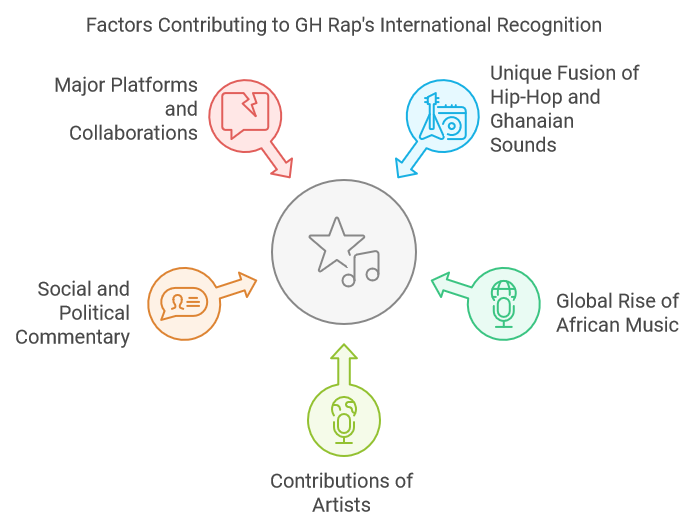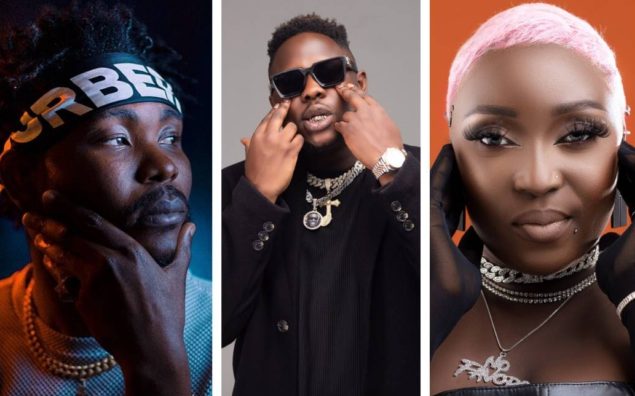Ghanaian hip-hop, often referred to as GH Rap, represents a vibrant fusion of American hip-hop with distinct Ghanaian influences, particularly the use of Twi (a local language) and highlife music. This hybrid genre has become a defining element of the modern Ghanaian music scene, blending the global appeal of hip-hop with the traditional melodies and cultural nuances of Ghana.
As we explore the development of GH Rap, we’ll uncover the genre’s deep roots in Ghanaian culture and how it has evolved into a powerful medium for social and political expression. Pioneering artists such as Reggie Rockstone, widely regarded as the “Godfather of Hiplife,” played a crucial role in establishing this genre. The blog will also explore the influence of subgenres like hiplife and the rise of Azonto, a dance style that took the world by storm in the early 2010s. These elements, among others, have shaped the unique identity of Ghanaian hip-hop, making it not only a form of entertainment but a cultural movement that resonates both locally and globally.
Origins of GH Hip-Hop
The Birth of GH Rap
GH Rap began to take shape in the late 1990s and early 2000s, during a time when American hip-hop was gaining widespread global influence. In Ghana, local artists began blending this foreign sound with their own cultural rhythms and languages. One of the key figures responsible for this fusion was Reggie Rockstone, an artist who is often credited with creating the hiplife genre—a predecessor and major influence on GH Rap.
Reggie Rockstone’s vision was to combine hip-hop beats with Ghanaian highlife music, a genre known for its upbeat tempos and melodic structures. By incorporating the local language, Twi, into his lyrics, Rockstone made the music more relatable to Ghanaians. His innovative approach led to the rise of GH Rap, a genre that preserved the essence of Ghanaian culture while tapping into the global hip-hop movement. This cultural blend allowed GH Rap to resonate with audiences both within Ghana and across international borders.
As GH Rap gained momentum, other artists like Sarkodie and M.anifest followed in Rockstone’s footsteps, further developing the genre and taking it to new heights. These artists continued to merge local sounds with contemporary hip-hop, establishing GH Rap as a powerful voice for Ghanaian youth and a medium for addressing social and political issues.
Influence of Hiplife on GH Hip-Hop
Hiplife’s Role in Defining Ghanaian Hip-Hop
Hiplife is a unique Ghanaian genre that blends traditional highlife music with modern hip-hop elements, becoming a defining force for the development of GH Rap. Originating in the 1990s, hiplife incorporates the rhythmic melodies of highlife, a genre known for its use of indigenous Ghanaian instruments and storytelling traditions, with the beats, flow, and lyrical style of American hip-hop.
One of the key characteristics of hiplife is its use of Twi rap, which allowed the genre to resonate deeply with Ghanaian audiences. This localized rap style, combined with digital production techniques and the infusion of American R&B elements, made hiplife both familiar and fresh to listeners. Twi, being one of the dominant languages in Ghana, gave the music an authentic voice that could speak directly to the everyday experiences of Ghanaians. Additionally, the fusion of Western musical styles with Ghanaian rhythms created a distinct sound that contributed to the cultural identity of GH Rap.
Artists like Sarkodie and M.anifest have played an instrumental role in elevating hiplife and GH Rap to a broader audience. Sarkodie, known for his rapid-fire delivery and lyricism in Twi, has become a cultural icon in Ghana, while M.anifest has brought intellectual and poetic depth to the genre, often addressing social, economic, and political themes in his music. Both artists have not only dominated the Ghanaian music scene but have also contributed to the international growth of hiplife and GH Rap by performing at global platforms and collaborating with foreign artists.

Evolution and International Recognition
From Local to Global
Over the years, GH Rap has grown from a local musical movement to gaining international recognition. This evolution has been driven by the global appeal of its unique fusion of hip-hop with Ghanaian sounds, along with the global rise of African music more generally. Artists like Sarkodie and M.anifest have become ambassadors of GH Rap, taking their music to stages around the world and introducing international audiences to the Ghanaian sound.
Social and political commentary forms a core theme in the music of these artists. Sarkodie, for example, often raps about issues facing the Ghanaian youth, from economic hardships to the importance of education. Similarly, M.anifest tackles topics such as corruption, identity, and empowerment in his lyrics, making their music resonate far beyond Ghana’s borders.
By blending local Ghanaian experiences with universal hip-hop themes of struggle, success, and self-expression, GH Rap has managed to bridge cultural divides and capture the interest of a global audience. Major platforms like the BET Awards and international collaborations with artists such as Ace Hood, Wale, and Stormzy have further cemented the global standing of GH Rap. Today, it stands as a dynamic, evolving genre that continues to represent the voice of modern Ghana to the world.
The Azonto Craze: A Dance Revolution
The Rise of Azonto
In the early 2010s, Azonto, a high-energy dance style that fused hip-hop rhythms with traditional Ghanaian music, burst onto the scene and quickly became a cultural sensation both in Ghana and around the world. With its roots in local street culture, Azonto is characterized by its playful, often humorous dance movements that mimic everyday actions like driving, boxing, or even ironing. These moves, combined with upbeat tempos and infectious rhythms, made Azonto incredibly popular, especially among Ghanaian youth.
Azonto music became synonymous with the dance, featuring fast-paced beats, heavy percussion, and a combination of English and Twi lyrics. Artists like Fuse ODG, with his global hit “Antenna,” and Sarkodie, with “U Go Kill Me,” propelled the Azonto craze to international heights. The dance, which could be improvised, allowed individuals to express themselves creatively, making it highly adaptable to both local and global contexts.
As the dance spread, so did its influence on GH Rap. The playful energy of Azonto, coupled with its vibrant rhythms, began to shape the sound of Ghanaian hip-hop, integrating faster tempos and more light-hearted, danceable beats. GH Rap artists incorporated Azonto rhythms into their music, creating a dynamic fusion that brought new life to the genre. This integration not only refreshed GH Rap but also expanded its appeal, making it more accessible and engaging for both local and international audiences. Azonto’s popularity helped cement GH Rap’s place on the global music stage and furthered the genre’s evolution.
Conclusion
Ghanaian hip-hop, or GH Rap, is a genre that continues to evolve while maintaining its deep cultural roots. Originating from a fusion of American hip-hop with traditional Ghanaian elements like Twi and highlife, it has grown into a distinctive genre that represents the voice of modern Ghana. Pioneering artists such as Reggie Rockstone, Sarkodie, and M.anifest have been instrumental in shaping the genre, using their music to address both social and political issues.
The rise of Azonto in the 2010s further expanded the identity of GH Rap, infusing it with vibrant dance rhythms and movements that took the world by storm. Through a combination of modern hip-hop beats and Ghanaian cultural expressions, GH Rap has gained international recognition, resonating with audiences far beyond its local origins.
As the genre continues to grow, its global influence is undeniable. GH Rap stands as a testament to the power of cultural fusion, blending Ghanaian traditions with contemporary hip-hop to create a genre that is not only entertaining but also deeply meaningful. Its rich history and evolving sound ensure that GH Rap will remain a vital part of the global music landscape for years to come.
7. References
- Wikipedia on Hiplife and GH Rap:
Hiplife on Wikipedia
GH Rap on Wikipedia - ProTour Africa’s article on Azonto:
ProTour Africa on Azonto
FAQ
1. What is the meaning of GH Rap?
GH Rap refers to Ghanaian hip-hop, a genre that fuses American hip-hop elements with traditional Ghanaian music such as highlife, as well as local languages like Twi.
2. Who is considered the “Godfather of Hiplife”?
Reggie Rockstone is known as the “Godfather of Hiplife.” He pioneered the fusion of hip-hop with Ghanaian highlife music, and his work laid the foundation for what we now call GH Rap.
3. What is Hiplife and how is it related to GH Rap?
Hiplife is a genre that blends traditional Ghanaian highlife with modern hip-hop elements such as beats, rap, and digital production. Hiplife was instrumental in shaping the identity of GH Rap by integrating local linguistic and cultural elements into the music, making it distinctly Ghanaian.
4. Which key artists helped popularize GH Rap and Hiplife?
Artists like Sarkodie and M.anifest are crucial figures in bringing GH Rap and Hiplife to the mainstream. Their use of Twi rap, socially conscious lyrics, and international collaborations helped make the genre globally recognized.
5. What is Azonto, and how did it impact GH Rap?
Azonto is a dance craze that emerged in the early 2010s, combining hip-hop rhythms with local Ghanaian music. It became a global phenomenon and influenced GH Rap by bringing a more upbeat, danceable quality to the music. Artists like Fuse ODG and Sarkodie contributed to its popularity.
6. How has Ghanaian hip-hop gained international recognition?
GH Rap gained international recognition through global performances, collaborations with foreign artists, and platforms like the BET Awards. Artists like Sarkodie and M.anifest became ambassadors of the genre by addressing universal themes such as identity, politics, and social issues, which resonate with global audiences.
7. What themes do GH Rap artists typically explore in their music?
GH Rap artists often tackle social and political issues, including youth empowerment, corruption, economic hardship, and cultural pride. This socially conscious approach adds depth to the music and helps it connect with audiences on a more personal level.
8. What is the difference between GH Rap and Hiplife?
Hiplife is an earlier genre that blends highlife and hip-hop, primarily focused on local Ghanaian sounds, often with Twi rap. GH Rap, on the other hand, is more closely aligned with modern hip-hop, but retains strong influences from Hiplife, making it a more global and dynamic genre.
9. What makes GH Rap unique compared to other African hip-hop genres?
GH Rap stands out for its deep cultural fusion, blending American hip-hop beats with Ghanaian highlife music and local languages like Twi. This makes the genre both culturally specific and globally appealing.
